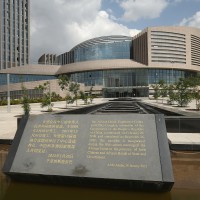
Postcards from Pan-Africa
ArticlesWhen reports (rumours) surfaced on that 9th of May, 2016, that Haiti, the land Aime Cesaire claimed is “where negritude stood up for the first time” had finally joined the African Union, Pan-Africanists the world round celebrated.
But with the rejoice came questions; queries about the AU itself, and whether or not an African Unionised idea of Pan-Africanism was Pan-African at all.
Since then, Enoh Eben, spokesman of the AU has denied the claims, stating “Haiti will not be admitted as a member state of the African Union at its next summit to be held in Kigali, Rwanda, as erroneously reported by several media outlets. Only African States can join the African Union.”
How’s that for Pan-Africanism?
This week on the Chronic we look at Pan-Africanism under Big Man politics, imperialist structural adjustments and international bodies of governance.
In Love and Learning under the World Bank, Stacy Hardy recounts seventeen stories of the hierarchies, the anti-heroes, the hard knocks and the histrionics that have been visited upon universities as a result of decades of decidedly imperialist structural adjustment.
Kangsen Feka Wakai traces the uncharacteristic journey through a “noisy era” of one of Africa’s heralded statesmen and reveals that his road less travelled has set him somewhat apart in the hood of the neo-liberal Big Man.
“It was an era of noise – the noise of development experts and foreign aid consultants, from crowded buses in crowded cities; noise from Kalashnikovs and landmines; noise from benefit concerts, from buzzing flies, from the groans of famished children and mothers; noise from the Congolese guitar riffs of Lokassa Ya Mbongo and noise from Manu Dibango’s horn and from Yvonne Chaka Chaka; noise about peace talks and containment; Les Têtes Brulées; noise from old loudspeakers, from Big Men in suits and berets; noise from Ronald Reagan’s United States of America; noise from PW Botha’s South Africa and noise from Fela’s Kalakuta Republic.
On the night of 19 October, 1986, the noise died when the plane carrying Machel crashed under mysterious circumstances as he returned from a summit of frontline states in Mbala, Zambia, a summit convened to find ways to isolate apartheid South Africa from its regional allies, Malawi and Zaire. In the aftermath of the crash, the noise resumed, surrounding Machel’s crash, the noise of plane engines and of inconsolable mourning; the noise of fluttering flags flying at half-mast; noise across borders and from weather conditions; the noise of whispering spooks and that of aeronautic communication signals.“
Paula Akugizibwe assumes observer status at the African Union and finds the ‘new sovereign’ in a state of afro-centric rebirth. But under the silky sheets of diplomacy and people-power pillowtalk, she discovers, is a charm offensive that puts paid to the ‘Renaissance’ and keeps the West in control.
“Having learnt from its military disasters of the early 1990s, the US, through the AU, has draped its operations in kente cloth and secured African solutions for American problems. “
For more, head to the Chronic
